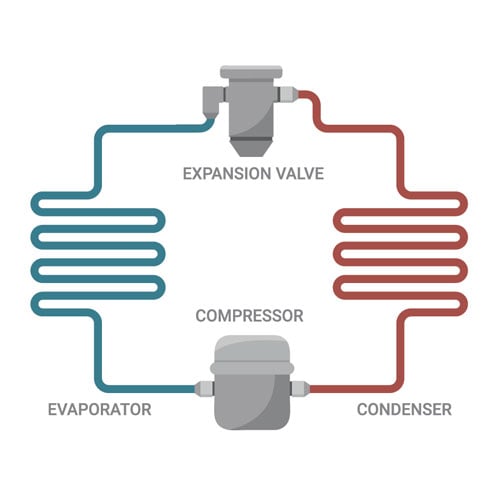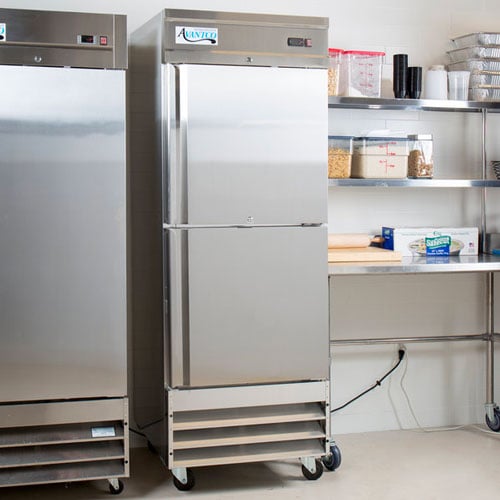
Refrigerants Explained
Last updated on 8/7/2019Refrigerant is essential for cooling refrigerators and air conditioners but it generally isn't a factor most people think about when making a purchase. However, with refrigerant laws changing and certain refrigerant types becoming illegal, it is important to understand the differences between the types of refrigerant when it comes to replacing your refrigerator or freezer.
Shop All Commercial RefrigeratorsWhat is Refrigerant?
Refrigerant is a cooling agent that absorbs heat and leaves cool air behind when passed through a compressor and evaporator. It fluctuates between a liquid or gas state as it goes through the thermodynamic process.
How Refrigerant Works

Here is how refrigerant cools the inside of refrigerators and the air for AC units:
- The refrigerant begins as a liquid when it passes through the expansion device in your unit. It expands and cools due to the sudden drop in pressure causing it to turn into a gas.
- As the gaseous refrigerant passes through the copper evaporator coil inside the unit, it absorbs the heat from the products inside.
- The unit’s compressor then pulls the refrigerant gas and the absorbed heat away from the food products, increasing the pressure of the gas.
- The hot, high-pressure refrigerant then passes through the condenser coils. As it does so, it radiates its heat into the atmosphere and cools back into a liquid.
- The liquid refrigerant reenters the expansion device and the process begins again.
Types of Refrigerant
The following refrigerant types are the most common you may encounter in your commercial equipment:
R-12 Refrigerant

- Components: ChloroFluoroCarbons (CFC), Methane Based
- Uses: Refrigerators and Air Conditioners
- ODP: 1.0
- GWP: High (10900)
- Eco-Friendly: No
- Flammable: No
- Banned in 1994
R-22 Refrigerant
- Components: HydroChloroFluoroCarbons (HCFC), contains less chlorine than CFCs
- Uses: Refrigerators and Air Conditioners
- ODP: 0.055
- GWP: Medium (1810)
- Eco-Friendly: No
- Flammable: No
- Will be banned by 2030
R-290 Refrigerant
- Components: HydroCarbons (HC), Propane based
- Uses: Refrigerators and Air Conditioners
- ODP: 0
- GWP: Low (6)
- Eco-Friendly: Yes
- Flammable: Yes
R-134a Refrigerant
- Components: HydroFluoroCarbon (HFC)
- Uses: Refrigerators, Car Air Conditioning
- ODP: 0
- GWP: 1430 (Medium)
- Eco-Friendly: Somewhat
- Flammable: No
R-404A Refrigerant
- Components: HydroFluoroCarbon (HFC)
- Uses: Freezers and Refrigerators
- ODP: 0
- GWP: High (3922)
- Eco-Friendly: No
- Flammable: No
R-410A Refrigerant
- Components: HydroFluoroCarbon (HFC)
- Uses: Refrigerators and Air Conditioners
- ODP: 0
- GWP: Medium (2088)
- Eco-Friendly: Somewhat
- Flammable: No
R-450A Refrigerant
- Components: HydroFluoroOlefin (HFO)
- Uses: Refrigerators, Car Air Conditioning
- ODP: 0
- GWP: Medium (547)
- Eco-Friendly: Yes
- Flammable: No
Environmentally Friendly Refrigerants

In order to comply with refrigerant regulations, here are some of the more environmentally friendly refrigerants to choose from when purchasing new heavy equipment online:
R-290
- Also known as Care 40
- Adheres to the SNAP Program passed by the EPA
- May have shipping restrictions due to its flammable nature
R-450A
- Was made as a replacement to R-134a
- Considered to be a high-efficiency and non-flammable option
- Great for refrigerators as well as beverage dispensers, vending machines, and water chillers
R-513a Refrigerant
- Also known as Opteon XP10
- Features an ODP of 0 and a low GWP of 573
- Is a highly efficient option for medium temperature refrigeration and air conditioning
R-600a Refrigerant
- Also known as Care 10 or Isobutane
- Becoming increasingly popular in commercial and residential establishments
- Features an ODP of 0 and a low GWP of 3
Refrigerant and Global Warming
A refrigerant’s environmental impact is measured by the following characteristics:
Ozone Depletion Potential (ODP)
- Range 0-1
- The closer the refrigerant measures to 1, the more harmful it is to the ozone layer
- Refrigerants that contain chlorine such as Freon or CFC refrigerants are most likely to contribute to ozone depletion
Global Warming Potential (GWP)
- Range 0-2500+
- Less than 150 would be considered low, 150-2500 is medium, and greater than 2500 would be a high GWP
- HCFC (HydroChloroFluoroCarbons) refrigerants have the highest GWP rating
Refrigerants with an ODP of 0 would be considered environmentally safe but not eco-friendly since they still have the potential to contribute to global warming.
Refrigerant Laws
Because of the negative impact on the environment, there are refrigerant regulations in place that have listed a variety of banned refrigerant and refrigerant types that are being phased out. These are just some of the laws in place:
- R-12 refrigerant, once the most popular refrigerant on the market, was banned in the early 1990’s for contributing to the greenhouse gas effect and all production ceased in 1994.
- R-22 refrigerant was made in the late 1990’s to temporarily replace R-12 due to its lower ODP. Production is expected to cease in 2020 and it will be entirely illegal by 2030 to comply with the Clean Air Act of 2010
- Refrigerant leaks must be fixed within 30 days and refrigerant must be recaptured, recycled, and disposed of properly by a certified technician to avoid fines.
- Refrigerators and air conditioners need to be disposed of properly according to EPA regulations.
Becoming familiar with the laws and regulations surrounding refrigeration can be extremely useful to keep you ahead of the trends and help you choose the best commercial refrigeration for your business.






